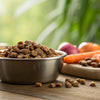Why Do Dogs Like Biscuits? Exploring the Fascination with Dog Treats
- Houndsy
Table of Contents
- Introduction
- The Evolution of Canine Taste
- The Science Behind the Appeal
- Conditioning and Association
- The Variety of Dog Biscuits
- How to Incorporate Biscuits into Your Dog’s Diet
- The Houndsy Kibble Dispenser: Elevating the Feeding Experience
- Conclusion
Introduction
Have you ever noticed how your dog’s eyes light up at the mere sight of a biscuit? It’s as if a magical spell has been cast, compelling them to sit, stay, and do anything for that delightful treat. But why do dogs like biscuits so much? This question resonates with many pet owners, especially those of us who have seen our furry companions forsake their regular food for a nibble of something crunchy and delicious.
In this blog post, we will delve into the fascinating world of dog biscuits, exploring the reasons behind dogs' fondness for these treats. We’ll look at the science behind their preferences, the role of smell and texture, and how we, as pet owners, can enhance their feeding experiences. By the end of this article, we hope to help you understand not just why dogs love biscuits, but also how to choose the right ones for your furry friends.
So, let’s embark on this tasty journey together—after all, every dog owner wants to know how to keep their pup happy and healthy!
The Evolution of Canine Taste
To fully understand why dogs like biscuits, we need to consider their history. Dogs descended from wolves, scavengers that thrived on the scraps left behind by humans. Over thousands of years, this relationship with humans has shaped not only their behavior but also their taste preferences.
Scavengers by Nature
Wolves are opportunistic feeders, eating whatever is available. When dogs were domesticated, they retained this trait. They learned to associate humans with food, developing a taste for whatever we offered them, including biscuits. This instinctive behavior means that treats are not just food but also a form of social interaction and bonding.
The Importance of Variety
Dogs, much like humans, can grow bored with a monotonous diet. While their kibble is formulated to meet their nutritional needs, it often lacks the variety and excitement that treats can provide. This is where biscuits shine. They offer a different flavor and texture, making them more appealing than the same bowl of kibble day after day.
The Science Behind the Appeal
Smell and Taste
Dogs have a highly developed sense of smell—estimated to be 10,000 to 100,000 times more sensitive than humans. This means that the aroma of a freshly opened bag of biscuits can be irresistible to them. The ingredients in many dog biscuits, such as meat, cheese, and fats, are designed to be enticing.
Furthermore, while kibble is typically formulated to be nutritious, it may not have the same robust flavors that biscuits offer. The additional fats and sugars in many treats enhance their palatability, making them far more attractive.
Texture Matters
The texture of biscuits also plays a significant role in their appeal. Dogs enjoy the crunchiness of biscuits, which can be satisfying to chew and can help clean their teeth. This is especially important for dental health and can reduce plaque buildup, making biscuits a fun, functional treat.
Conditioning and Association
Treats as Rewards
Many dog owners use treats as rewards during training or for good behavior. This creates a positive association in the dog's mind—treats equal good times and praise. When we give our dogs a biscuit, it’s often during moments of affection or excitement, reinforcing their love for these treats.
The Role of Routine
Routine also plays a critical role in a dog’s excitement for biscuits. If you regularly reward your dog with a biscuit after a walk or training session, they will begin to associate that activity with the treat. This predictable pattern heightens their anticipation and eagerness for biscuits.
The Variety of Dog Biscuits
With countless options available on the market, it can be overwhelming to choose the right biscuits for your dog. Here, we’ll break down the types of biscuits and what to consider when selecting them.
Types of Dog Biscuits
-
Traditional Biscuits: These are the classic crunchy treats that many dogs love. They often come in various flavors, such as chicken, beef, or peanut butter.
-
Soft Chews: Ideal for older dogs or those with dental issues, soft chews offer the same tasty flavors in a gentler texture.
-
Dental Treats: These biscuits are specifically designed to promote dental health, helping to reduce tartar and plaque buildup while freshening breath.
-
Grain-Free Options: For dogs with sensitivities, grain-free biscuits provide an alternative without common allergens like wheat or corn.
-
Homemade Biscuits: Making your own dog biscuits can be a rewarding experience. You can control the ingredients, ensuring they are healthy and free from preservatives.
Nutritional Value
While biscuits are treats, it’s essential to consider their nutritional value. High-quality biscuits will have ingredients that contribute to your dog’s health, such as vitamins, minerals, and protein sources. Look for options that prioritize whole food ingredients over fillers.
How to Incorporate Biscuits into Your Dog’s Diet
Moderation is Key
While biscuits can be a delightful addition to your dog's diet, they should be given in moderation. Treats should not make up more than 10% of your dog’s daily caloric intake. This helps prevent obesity and ensures that your dog’s main meals still provide the necessary nutrients.
Use as Training Aids
Incorporating biscuits into training routines can enhance your dog’s learning experience. Use small pieces of biscuits as rewards for good behavior or during training sessions. This positive reinforcement can motivate your dog to learn new commands and tricks.
The Houndsy Kibble Dispenser: Elevating the Feeding Experience
At Houndsy, we believe that the feeding experience should be as enjoyable as the food itself. That’s why we’ve developed the Houndsy Kibble Dispenser. This innovative product not only provides your dog with their daily kibble in a fun and engaging way but also ensures convenience for you. With its mid-century modern design and ergonomic features, our dispenser elevates the entire feeding ritual.
Benefits of the Houndsy Kibble Dispenser
- Convenience: The convenient crank allows for easy dispensing at standing height, eliminating the need to bend over, making it easier for pet owners.
- Perfect Portions: Delivering the right amount of kibble every time ensures consistent feeding and helps with weight management.
- Stunning Design: Its aesthetic complements modern home decor, making it a stylish addition to your living space.
- Safe & Reliable: Made with high-quality materials, the dispenser features a BPA-free liner and an auto-locking mechanism to prevent accidental dispensing.
If you're interested in transforming your dog's feeding routine, explore the Houndsy Kibble Dispenser.
Conclusion
Understanding why dogs like biscuits involves a blend of evolutionary history, sensory appeal, and emotional associations. The crunchiness, variety, and rewarding nature of biscuits make them an irresistible treat for our furry friends. As responsible pet owners, it’s crucial to choose high-quality biscuits that contribute positively to our dog’s health and well-being.
Incorporating biscuits into your dog’s diet can enhance their experiences, making routines more enjoyable and rewarding. We hope this exploration has provided you with insight into your dog’s preferences and how you can make their feeding experience delightful.
FAQ
1. Are biscuits a healthy treat for dogs? Yes, when chosen wisely, biscuits can be a healthy treat for dogs. Look for those made from high-quality ingredients and free from fillers or artificial additives.
2. How often can I give my dog biscuits? Treats should not exceed 10% of your dog’s daily caloric intake. This helps maintain a balanced diet and prevents obesity.
3. Can I make homemade biscuits for my dog? Absolutely! Homemade biscuits allow you to control the ingredients and ensure they are healthy and safe for your dog.
4. Are there specific biscuits for dogs with allergies? Yes, there are grain-free and limited ingredient options available for dogs with allergies or sensitivities.
5. How can I encourage my dog to eat their kibble? Consider using the Houndsy Kibble Dispenser to make feeding more engaging, or mix in small amounts of soft, tasty treats with their kibble to entice them.
Take the next step in enhancing your dog’s feeding experience and explore our Houndsy Kibble Dispenser today!













